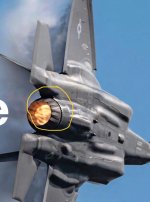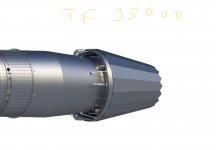Latest Thread
You are using an out of date browser. It may not display this or other websites correctly.
You should upgrade or use an alternative browser.
You should upgrade or use an alternative browser.
Wow!Kaan has not flown with indigenous flight controller etc.
Same story as Hurjet. They promote it as fully indigenous until the promotion period ends and then they tell "well actually not all components".
View attachment 66204
You must have more knowledge than anybody else in this matter.
Guys calm down, no need for personal attacks. This is not what I am saying, it is Tubitak. Attack Tubitak of you want.
Instead lets talk why Kaan was not using indigenous flight controller etc. that were previously advertised as delivered before the first flight.
Instead lets talk why Kaan was not using indigenous flight controller etc. that were previously advertised as delivered before the first flight.
It is the pilot who controlled the flight and he is indigenous, delivered long time ago.Guys calm down, no need for personal attacks. This is not what I am saying, it is Tubitak. Attack Tubitak of you want.
Instead lets talk why Kaan was not using indigenous flight controller etc. that were previously advertised as delivered before the first flight.
Notably FCC and some actuators.Apart from the engine and ejection seat, what foreign systems were in the prototype that flew? If there were some, when will they be replaced by Turkish systems?
Both will be replaced by Turkish systems in the 2nd prototype
Kaan has not flown with indigenous flight controller etc.
Same story as Hurjet. They promote it as fully indigenous until the promotion period ends and then they tell "well actually not all components".
View attachment 66204
"Flight Control and Aircraft Management Computers
These are computers that manage the engine, flight control surfaces (wings) and other aircraft systems. It was used in KAAN's first flight."
Milli Muharip Uçağı KAAN, İlk Uçuşunu Gerçekleştirdi | TÜBİTAK | Türkiye Bilimsel ve Teknolojik Araştırma Kurumu
T.C. Sanayi ve Teknoloji Bakanlığı'nın ilgili kuruluşudur.
Thanks. This is interesting. Tubitak tweet and website have contradicting information."Flight Control and Aircraft Management Computers
These are computers that manage the engine, flight control surfaces (wings) and other aircraft systems. It was used in KAAN's first flight."
Milli Muharip Uçağı KAAN, İlk Uçuşunu Gerçekleştirdi | TÜBİTAK | Türkiye Bilimsel ve Teknolojik Araştırma Kurumu
T.C. Sanayi ve Teknoloji Bakanlığı'nın ilgili kuruluşudur.www.tubitak.gov.tr
They're quite transparent in the slide. If they'd used a Leonardo FCS they'd mention it. "Computers: TUBITAK".
Secondo Mona, fuel system (Italy)
OMA, hydraulic power (Italy)
Martin Baker, ejection seat (UK)
General Electric, engines (USA)
Airtificial, active sidestick (Spain)
Aerosonic, air data system (USA)
Last edited:
Thanks. This is interesting. Tubitak tweet and website have contradicting information.
My theory, BİLGEM piggybacked FCS off other computers like the Central Management Computer, since they share a common architecture. The other computers don't do a lot right now, so it makes sense. Therefore, I believe the systems are in-house, but a full independent computer isn't installed for flight controls. Hence BİLGEM isn't confident announcing it's "used on the first flight", but TÜBİTAK management probably doesn't mind not making this distinction.
You can't fly this fully digital aircraft without a flight computer and you can't buy a flight computer from somewhere and fly your aircraft with it. It doesn't work that way. Probably an early version or another flight computer that is enough to make the first flight is used while the flight computer that will have the full capability is in development.
NRFRT means Near Field Rcs Test Facility. It is irrelevant and has nothing to do with the first flight. It will be ready this year.
EMC test system has nothing to do with the first flight.
A mission computer is not needed for a first flight it is evident that this aircraft is neither mission-ready nor carries any mission-specific sensors like a radar.
I think the high-speed network is self-explanatory it is not going to use network capability anytime soon.
NRFRT means Near Field Rcs Test Facility. It is irrelevant and has nothing to do with the first flight. It will be ready this year.
EMC test system has nothing to do with the first flight.
A mission computer is not needed for a first flight it is evident that this aircraft is neither mission-ready nor carries any mission-specific sensors like a radar.
I think the high-speed network is self-explanatory it is not going to use network capability anytime soon.
Last edited:
It would be beneficial for the relations to be more cordial for the KSA to take the step to realize the 5-ship MILGEM project, which was canceled at the last moment when all the details of the agreement had been agreed upon, and which also offered the possibility of co-production, which no other country offered.Looks like KSA is going for full run to Turkish toys, Kaan is 1 of them.
KAAN should be the next step, contrary to what has been said, KAAN is definitely not a program that will have funding problems. First we need to see sincerity with the KSA on the issues that were on the table before.
should be next week, dont count on me thoWhen will the second flight be executed?
I wish I could be as confident as you while giving 100% incorrect information.you can't buy a flight computer from somewhere and fly your aircraft with it. It doesn't work that way.
Lol Hurjet program is different and has nothing to do with how the Kaan program progresses. Italian companies were a part of the project from the start. It is not the same thing.I wish I could be as confident as you while giving 100% incorrect information.
It doesnt matter does it?Kaan has not flown with indigenous flight controller etc.
Same story as Hurjet. They promote it as fully indigenous until the promotion period ends and then they tell "well actually not all components".
View attachment 66204
First flight 13 minutes,that was the important part,nothing else.
It flew!
If block 10 is still not indigenous(i dont mind MB),then we can be angry.











